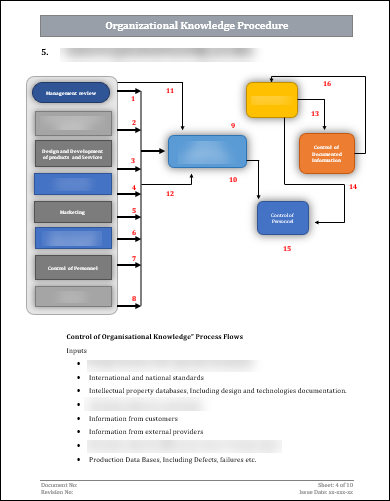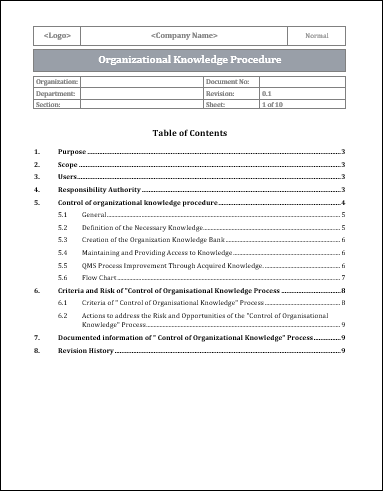ISO 9001 Organisational Knowledge Procedure Template
The ISO 9001 Organisational Knowledge Procedure Template is a comprehensive document that outlines the steps and guidelines for effectively managing organisational knowledge within an organization. This procedure is designed to help organizations identify, capture, and retain their knowledge assets, ensuring that valuable information is accessible and utilized effectively.
The Importance of ISO 9001 Organisational Knowledge Procedure Template
- Standardization: ISO 9001 is a globally recognized standard for quality management systems. Implementing ISO 9001 helps organizations improve their processes and systems, ensuring that products and services meet customer requirements consistently. The use of an organizational knowledge procedure template ensures that all employees follow a standardized process when managing and maintaining knowledge within the organization.
- Capturing and transferring knowledge: Organizational knowledge is crucial for the long-term success of an organization. It includes tacit knowledge, explicit knowledge, and experience gained through various activities. By using an ISO 9001 organizational knowledge procedure template, organizations can establish a structured approach to capture and transfer knowledge. This helps in retaining critical information and expertise within the organization, even when employees leave or retire.
- Risk mitigation: In today's rapidly changing business environment, organizations face various risks such as losing key employees, changes in technology, and evolving customer needs. By documenting and managing organizational knowledge using an ISO 9001 template, organizations can mitigate these risks. The template helps identify critical knowledge areas and ensures that necessary actions are taken to preserve and update knowledge in a timely manner.
- Continuous improvement: ISO 9001 emphasizes the importance of continuous improvement to enhance organizational performance. A well-designed organizational knowledge procedure template enables organizations to continuously review and update their knowledge base. This ensures that outdated information is not relied upon and that the organization remains competitive and relevant in the market.
- Compliance and certification: Adhering to ISO 9001 requirements is essential for organizations seeking certification or maintaining their certification. The use of an organizational knowledge procedure template helps organizations meet the ISO 9001 standard's requirements related to knowledge management. It provides a systematic approach for documenting, updating, and utilizing knowledge, thereby supporting organizations' efforts to achieve and maintain certification.
Key Components of ISO 9001 Organisational Knowledge Procedure Template
- Description of Change:The ISO 9001 Organisational Knowledge Procedure Template includes a section that outlines how changes to the procedure should be documented and managed. This ensures that any updates or modifications to the procedure are properly recorded and communicated to relevant personnel.
- Control of Documented Information:The template also includes instructions on how to manage and control documented information related to organisational knowledge. This involves establishing procedures for creating, reviewing, distributing, and updating documentation to ensure accuracy and accessibility for all relevant personnel.
- Control of Personnel: Another key component of the template is the section on controlling personnel. This includes guidelines for ensuring that employees have the necessary skills, knowledge, and experience to perform their assigned tasks effectively. It also addresses the training and development of personnel to enhance their competency and improve overall organisational knowledge.
- QMS Processes:The ISO 9001 Organisational Knowledge Procedure Template outlines how the management of organisational knowledge is integrated into the overall Quality Management System (QMS). It describes how organisational knowledge is identified, captured, and shared across various processes within the organization. This ensures that knowledge is effectively utilized to enhance the quality of products or services.
- Revision Number: To ensure clarity and traceability of changes made to the procedure, the template includes a revision number. This allows for easy identification and tracking of the different versions of the procedure, ensuring that all personnel are aware of the most up-to-date information.

Benefits of ISO 9001 Organisational Knowledge Procedure Template
The ISO 9001 Organisational Knowledge Procedure Template offers several benefits to an organization. Here are some pointwise explanations of these benefits:
- Standardization: Implementing this template helps standardize the organizational knowledge management process. It provides a systematic approach that ensures consistent handling and documentation of critical information within the organization.
- Compliance with ISO 9001: By using this template, organizations can demonstrate compliance with the ISO 9001 standard, focused on quality management systems. Compliance with ISO standards improves an organization's reputation and its ability to attract and retain customers.
- Efficient knowledge management: The template provides guidelines for capturing, organizing, and updating knowledge within the organization. This enhances efficiency and facilitates effective decision-making by ensuring quick access to relevant information.
- Mitigating knowledge loss: Organizational knowledge can be lost due to retirements, turnover, or other factors. The template helps organizations document and transfer knowledge to mitigate the impact of knowledge loss. This ensures continuity in operations and prevents rework or mistakes caused by the absence of critical knowledge.
- Enhancing employee development: The template encourages organizations to identify knowledge gaps and create strategies for filling them through employee training and development programs. This enhances employees' skills and competencies, leading to improved performance and productivity.
- Facilitating innovation: Knowledge sharing and collaboration are essential for fostering innovation within an organization. This template promotes the culture of sharing knowledge, enabling employees to learn from each other and come up with innovative ideas and solutions.
- Risk management: By effectively managing and preserving organizational knowledge, organizations can prevent risks associated with inadequate or outdated information. This template helps identify and capture critical knowledge, reducing the likelihood of errors or failures.
- Continuous improvement: The template promotes the concept of continuous improvement by evaluating and updating organizational knowledge regularly. It encourages organizations to learn from past experiences, identify areas for improvement, and implement necessary changes to enhance performance and customer satisfaction.
- Competitive advantage: A well-managed organizational knowledge base can provide a significant competitive advantage. It enables organizations to respond quickly to market changes, deliver high-quality products or services, and enhance customer satisfaction, giving them an edge over competitors.
Conclusion
In conclusion, the ISO 9001 Organisational Knowledge Procedure Template provides a comprehensive and structured approach for organizations to effectively manage their knowledge assets. By implementing this procedure, organizations can ensure that knowledge is captured, shared, and utilized throughout the organization to support decision-making, enhance performance, and drive continual improvement. This template not only aligns with the requirements of ISO 9001, but also promotes a culture of learning and innovation within the organization. By fostering a proactive approach to knowledge management, organizations can stay competitive in today's rapidly changing business environment.


